
The Bucky Clause

So now that we’ve established the importance of the Falcon in my southeast San Diego neighborhood, let’s review his establishment as Captain America’s partner.
Wait, we can’t do that yet. First, we have to make room for the Falcon. To do that, we have to get rid of Bucky.
Bucky? WTH is Bucky?
Bucky was the World War II Era sidekick of Captain America. Orphaned by the death of his father during a training accident on a stateside Army base, 15-year-old James Buchanan Barnes became the unit’s mascot and shipped off with them to the European Theater. The unit just happened to also include a clumsy private named Steve Rogers, aka Captain America. Once overseas, Bucky discovered Private Rogers changing into costume, begged to join him as his partner in combat, and Captain America and Bucky were born. The pair ravaged Nazi plans at home and abroad, and were a major factor in the Allies’ eventual triumph.
The popularity of superheroes, and the Golden Age of comic books, faded after World War Two. Captain America and Bucky only occasionally appeared in the pages of Timely Comics, Marvel’s predecessor. The younger sidekick was seriously wounded in a 1948 story, and seemingly sidelined permanently. After a long hiatus, the Captain America and Bucky characters were both revived for a short run in 1953-1954, this time fighting Communist villains. The victim of flagging sales, the series was again discontinued, less than two years before the publication of the new Flash over at DC heralded the renewed popularity of superhero comics and the beginning of the Silver Age.
So does that end our Captain America blog posts? Of course not. Captain America, and at least the idea of Bucky, were saved by something called Retroactive Continuity, or retcon for short. Retcon is simply a literary device that adjusts established facts in order to break continuity with a previous narrative.
The Golden-Silver Age Captain America was entirely a creature of retcon as Stan Lee revived the moribund character. To generate a new Captain America story arc, Lee completely ignored the existence of the sporadic postwar appearances of Captain America and Bucky. In Avengers #4, published in March, 1962, we discover that a disaster had befallen the Fascist-fighting pair in the closing days of World War Two, as they climbed aboard a bomb laden drone aircraft launched by the villainous Baron Zemo. Bucky was killed while trying to defuse the bomb. The explosion hurled Cap into the icy-cold ocean, preserving his body in a block of ice for 17 years. The Avengers discover Cap’s frozen body and revive him, thereby establishing Captain America as a major character in the Marvel Silver Age stable.
The discontinuity between the original Captain America story arc, and Lee’s reborn Captain America are cleaned up about a decade later, when it is established that the late 1940s-early 1950s Captain America was another individual who took on Cap’s identity after the original’s death.
Regardless, the 1962 Captain America timeline firmly establishes that Bucky Barnes was dead. So the path was clear for the Falcon to become Cap’s partner.
Well, not so fast.
Whether by time machine or deep freeze, sorcery or a newly discovered ruse, dead comic book characters have a nasty habit of coming back. This is particularly true during the Modern Age, as the supposed “deaths” of characters happens with depressing frequency in an attempt to boost sales (I just decided that I’m going to rant about this in a future post).
Yet there were resurrections in the Bronze Age too. Virtually every villain in the Marvel Universe has been, at one time or another, resurrected, and it was for interesting villains that resurrection was typically reserved. However, main characters could utilize resurrection too. Jean Grey-Marvel Girl came back as the Phoenix in 1980, after a supposed death upon re-entry into Earth’s atmosphere. Gwen Stacey came back as a clone in 1975. The Avengers #4 storyline could count as a resurrection.
So a resurrected Bucky could have crowded the Falcon out. However, the way for the first African American superhero was seemingly safe, because during the Golden Age, potential resurrection wasn’t an option for every character. Disqualification for rebirth had in fact evolved by the late 20th century into a maxim regarding dead comic book characters. Known as the “Bucky Clause,” it goes like this:
“No one stays dead except Bucky, Jason Todd and Uncle Ben.”
Jason Todd was the second “Robin,” moved into the slot after Dick Grayson outgrew the role of teen sidekick. He was killed in an explosion after being beaten with a crowbar by the Joker, his fate determined by a fan poll conducted by 1-900 calls. Uncle Ben was of course Peter Parker’s uncle, killed by a criminal that Peter allowed to escape. No dead Uncle Ben, no motivation for becoming Spiderman, sales plummet. And then there’s Bucky.
Bucky….
I know, I know. Bucky did come back to life in 2005 with the development of the “Winter Soldier” narrative, which has the teen rescued and turned into an assassin by his Soviet captors.
But the Bucky Clause was an unbreakable rule during the Bronze Age. It was difficult enough to believe that Cap was preserved in ice between 1945 and his discovery by the Avengers in 1962, but for both heroes to survive would have pushed the limits. More importantly, Lee said that he didn’t like the teen sidekick archetype that dominated most DC titles. You know, Robin, Superboy, Aqualad, Kid Flash, Wonder Girl, and so on.
With an emerging youth culture, you would think that Bucky would be a relatable character for young readers amid all the 20-ish heroes in the Marvel Universe, but that’s what Peter Parker and the X-Men were for. Besides, Bucky was definitely second fiddle to Cap, and taking orders from older authority figures would not sit well with Marvel’s high school and college age patrons.
Still, it took a good year to put the final stake in Bucky’s heart.
Marvel seemingly accomplished this feat with Avengers #56, which appeared in September, 1968. It was here that Cap, forever plagued by the death of his young sidekick, was able to commandeer a time machine created by Fantastic Four arch nemesis Dr. Doom. With the help of the Avengers, Cap journeys back to 1945 to discover if Bucky had in fact been killed in the drone explosion. Bucky does indeed disappear in a blinding flash, supposedly bringing a sense of closure to his story.

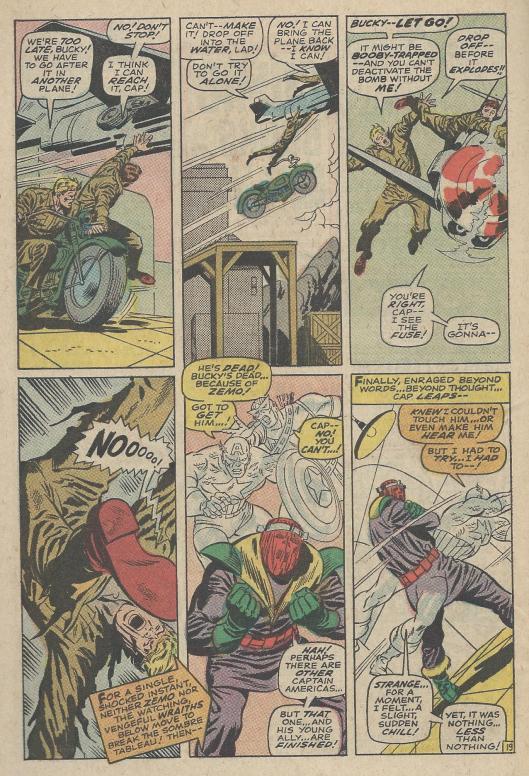
But if Bucky Barnes was indeed dead, for editor-author Stan Lee, the idea of Bucky the sidekick was not. In February, 1969, in Captain America #110, Cap meets Rick Jones, a teenage character who, at the time, had been appearing in the pages of the Incredible Hulk, acting as the green-skinned behemoth’s occasional mediator. After encountering the Hulk in a wild rampage, Cap rescues Rick Jones, and takes the loner in. Rick has a striking likeness to Bucky. Rummaging through Cap’s things, Rick finds an old Bucky costume and puts it on. After a heated exchange, Cap agrees to take Rick on as a new partner, and the new Captain America and Bucky begin a protracted battle with Hydra, an organization that rose out of the ashes of Nazi Germany to destroy the Free World.
Titled “No Longer Alone,” Captain America #110 was the first issue penciled by the incredible Jim Steranko, and appears to be Lee’s definitive statement regarding Cap as a solo character. Sales were not the best after Cap was moved from a two story magazine that also featured Iron Man, and it seems Lee felt that the character needed a sidekick to move the magazine off the racks. So it appears that the Bronze Age Captain America, like his Golden and Silver Age predecessor, was going to have a partner. It was not, however, clear on who that partner would be.
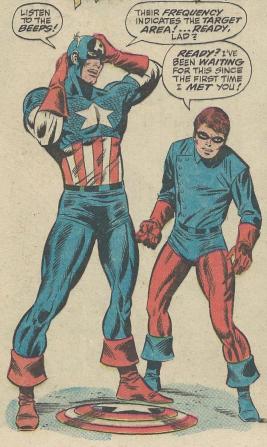
In March, 1969, one month after the publication of “No Longer Alone,” and the establishment of Rick Jones as Cap’s new partner, Marvel’s New York offices received a copy of an opinion piece by D.A. Latimer that appeared in the East Village Other, a New York underground newspaper, criticizing the absence of black characters in the Marvel universe. Marvel shot back, pointing out the existence of T’Challa, and non-superheroes like Joe Robertson, Willie Lincoln, and a few others. The letter also mentioned a new superhero called “THE FALCON,” although the character had yet to appear in print, and would not until June.
Lee introduced the idea of the Falcon in a talk at Duke University the previous February, roughly a month before the Latimer piece. Therefore, Latimer’s criticism wasn’t a catalyst for the appearance of a new African American superhero, but it could have impacted the question of who Cap’s permanent partner would be.
Marvel received a copy of the East Village Other critique a month after “No Longer Alone,” and the same month as the publication of Captain America #111, another Steranko masterpiece, where Rick Jones, in full Bucky garb, once again joins Cap on a brilliantly conceived cover collage. In “Tomorrow You Live, Tonight I Die!!” Cap rescues Rick from the clutches of Hydra before staging his own death to throw the villains off his trail. The following issue was essentially a memorial for the supposedly deceased Cap, told largely in a series of flashbacks. Yet Rick Jones/Bucky reappears in #113 on another wonderful Steranko cover, and plays a major role in helping Cap defeat Hydra, a role he continues in a similar battle with A.I.M. in #114.
It was in Captain America #114, published in June, 1969, four months after the East Village Other article, that the Captain America-Rick Jones-as-Bucky narrative, so promising a few months earlier, began to crumble. Lee’s plot featured the return of the Red Skull as the main antagonist. Back from the defeat of his Fourth Sleeper, the Skull has acquired the Cosmic Cube (look that up if you don’t know what it is, but yes, Thanos wasn’t the first one to use it to achieve evil ends). Using the Cube to switch bodies with Cap, the Red Skull teleports the real Cap to an island inhabited by exiled Nazis, shuns Rick, and plots his next move. Rick is devastated, imagining Cap’s behavior as a not too subtle hint that the partnership is over.
Although I’ll leave the details to my next post, the Falcon is introduced in Captain America #117, and it is the new hero, not Rick Jones, who helps defeat the Exiles, and, ultimately, the Red Skull. Rick is left stateside, moping about Cap’s disappearance even as the latter is training Sam Wilson to become the Falcon.
This is a totally unexpected twist after the promising start to the Cap/Rick Jones relationship, but not completely surprising given the East Village Other’s attack. Dedicated to expanding the diversity of its pool of characters within the context of 1969, Marvel was well on its way to creating the Falcon that January. However, where the Falcon landed may, just may, have been impacted by the D.A. Latimer piece. In other words, Latimer may have cost Rick Jones his job.
The Bronze Age Bucky makes a final appearance in Captain America #132, penciled by Gene Colan. Nazi villain Baron Strucker recruits a lookalike Bucky to destroy Captain American. Drafted from a local gym, the lookalike claims to have amnesia, and Strucker considers the possibility that the lad may indeed be the long-lost Bucky Barnes. However, the individual recruited by Strucker is in fact an android, commissioned by the horribly deformed Modok, master of A.I.M. (Advanced Idea Mechanics) and built by Dr. Doom in order to infiltrate their own schemes into Strucker’s plans. Modok, controlling the android Bucky from his lair, orders the imposter to kill Captain America. Still ridden by guilt, Cap offers a feeble defense, and is systematically pummeled by the android.

Gene Colan, who’s artistry was so flowing, was at his best during the sequence, capturing the imposter’s rage. Programmed with the original Bucky’s memories, the reader is given the sense that perhaps the original may have blamed Cap for his death had he lived.
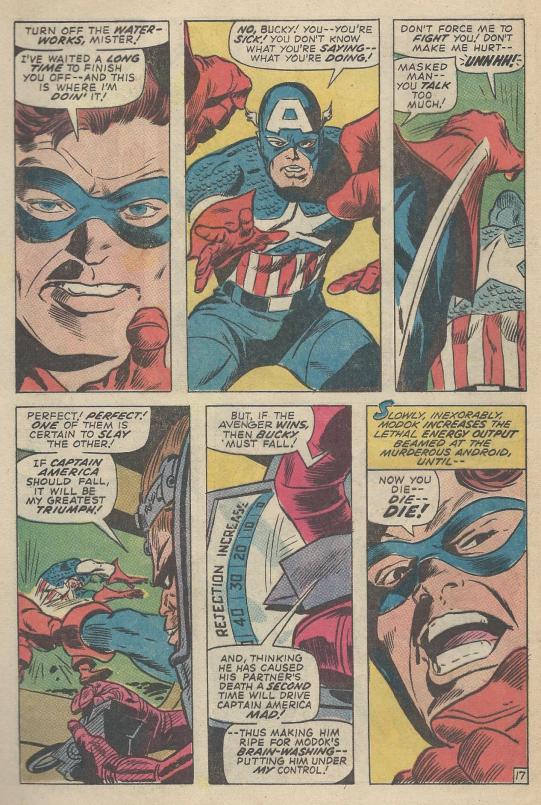
The climactic scene comes as Bucky is about to hurl a boulder onto the helpless Cap. However, the android hesitates, inhibited by the real memories Doom placed into his artificial brain in order to perfectly mimic the original. Overwhelmed by the conflict inherent in killing Cap, the android’s auto-destruct system is activated, and he detonates before finishing Cap off.
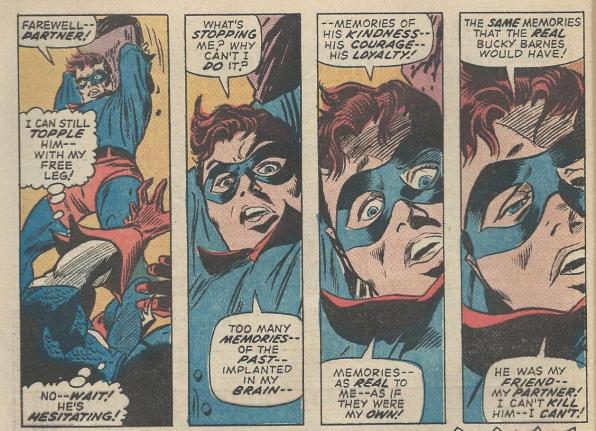
With the android’s destruction, we have the final attempt to resurrect Bucky Barnes in the Golden Age.

There would only be a single issue of Captain America after #132. Interestingly, the next issue’s preview box reads “No Longer Alone!” the same title as Captain America #110, where we saw the debut of Rick Jones as the new Bucky. But Rick is gone, having been paired with a new superhero, namely Captain Mar-Vell, in Captain Marvel 17 (October 1969).
So the Bucky Clause held firm as Marvel entered the Bronze Age. Beginning with issue #134, the magazine feature Captain America would be titled: Captain America and the Falcon.
Posted in: Uncategorized
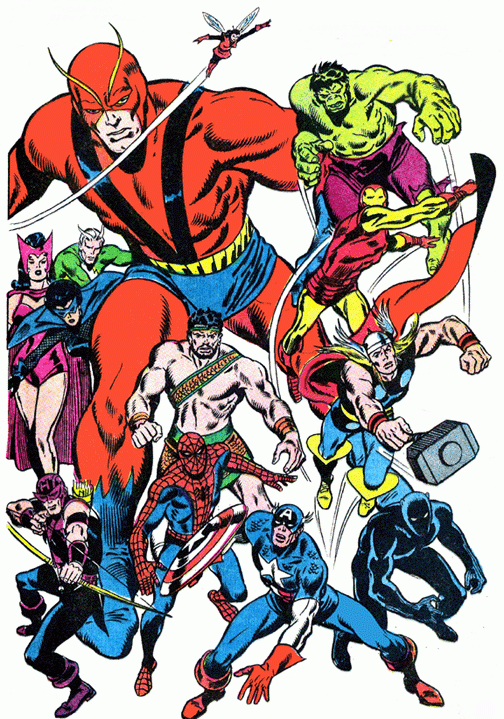
This was a fascinating post! I discovered your site while doing research for my own blog, “Attack of the 50 Year Old Comic Books” (https://50yearoldcomics.wordpress.com), which covers some of the same ground as yours. I certainly hope you’ll continue writing!
LikeLike
Hi Alan. Thanks for the comments. I’m tied up on another project till the first of the year but just updated my “about” page to say that I will be returning to the blog then. I miss working on it, so I will be back. Just checked out your incredible blog and it is fantastic. Thanks for the comments and will be back soon! Robert
LikeLike